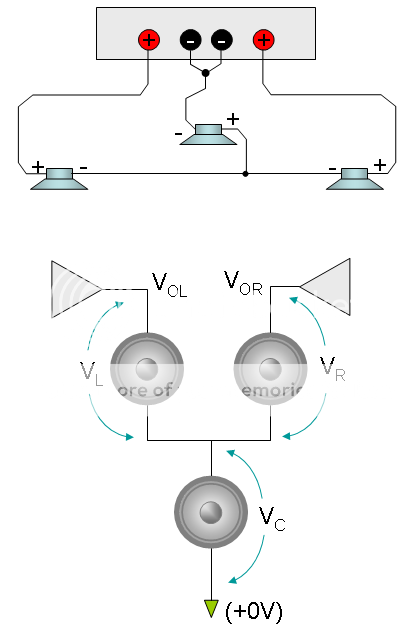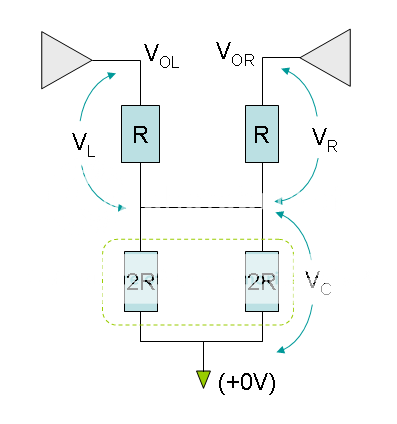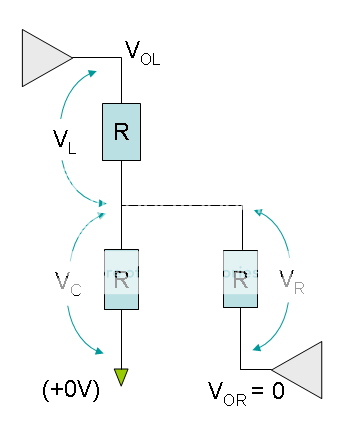In that omni thread, I remember you use original R/L for the B200. Any reason for that?
Yes, I was only interested in the effect of reflections from certain angles.
How do you resist the temptation of
1. bigger listening area
2. higher resolution of imaging
provided by that Linear-matrix paper?
Is it because another paper?
1. bigger listening area
2. higher resolution of imaging
provided by that Linear-matrix paper?
Is it because another paper?
Magnepan has recently been doing 3 channel stereo that they call "Tri-Center".
Some of the forums and WideScreen Review magazine have commented on it.
Some of the forums and WideScreen Review magazine have commented on it.
Hi there,
Let's rewind a bit.
As mentioned in post#4, I'm using the connection as below:

Redraw as below:

Now it's interesting. When the L=R, i.e., center image in stereo signal,
VOL = VOR
VL = VR = Vc / 2
So, the center is 6dB louder than L or R, but would be the same as the sum of L&R. That means center heavy when playing mono signal, which is a good thing -- center image would be more stable.
Now fully pan to the left, VOL = 1; VOR = 0

VL = 2 VR = 2 Vc
All channels are playing the same (left channel) signal, with 6dB down on center and right. And the right is at the opposite polarity.
Imperfect impedance load of the drivers aside, I guess it's pretty much the same as the description in the paper of Linear Matrix 😀 No?
Can anyone do a sanity check for me? 🙂
Let's rewind a bit.
As mentioned in post#4, I'm using the connection as below:

Redraw as below:

Now it's interesting. When the L=R, i.e., center image in stereo signal,
VOL = VOR
VL = VR = Vc / 2
So, the center is 6dB louder than L or R, but would be the same as the sum of L&R. That means center heavy when playing mono signal, which is a good thing -- center image would be more stable.
Now fully pan to the left, VOL = 1; VOR = 0

VL = 2 VR = 2 Vc
All channels are playing the same (left channel) signal, with 6dB down on center and right. And the right is at the opposite polarity.
Imperfect impedance load of the drivers aside, I guess it's pretty much the same as the description in the paper of Linear Matrix 😀 No?
Can anyone do a sanity check for me? 🙂
I use the following in Reaper JS to create the LCR.. This is similar to the Trinaural method (Dont know for sure) but done in a Reaper JS plugin....
Im no programmer. So i think there are some improvements to be made.
Didn't see this thread earlier. The approach optic coded here is the Meridian Trifield approach - I've also implemented this independently in Reaper JS scripting. The image that optic includes comes from the original paper which I think I had to purchase from IEEE, but gives you all the background and detail on the approach. This is somewhat empirical, but there was a lot of work put into making it a percieved 'optimal' approach - they discovered that higher and lower freqs were localized differently, and so needed different matrix coefficients. Their aim was to be able to pan pink noise seamlessly from side to side without any percieved image spreading - IMHO they did a pretty good job.
I can verify that it works very well, even in nearfield on a desktop. Search the 'net for Trifield opinions - there are a lot of folks out there with expensive Meridian systems that use this as their default music mode. I probably would be too if I hadn't taken a left turn with the NHT Xds system, since I only have 2 of the NHT monitors.
CLS, that's an interesting setup. Are you running it that way now? From my experience some amps are not happy with speakers connected between the + and + terminals. But since you are connecting to ground thru your center, that might make the amp happier.
Interested to know how it's working for you.
Interested to know how it's working for you.
I'm subscribed. I'm actually thinking of trying something like this in my car especially for live albums. Could add an interesting effect.
Yes, I'm using such connection right now. It's working very well.
It's an ordinary SS amp with MOSFET output stage, and the negative output terminals of both channels are in common ground.
I'm also very pleased with the overall effect -- very wide and deep sound stage, very stable and also natural imaging. The effect of "vector-imaging concept" in the paper -- steering the images beyond the outer edges of speakers, seldom happens, though. I guess there's inevitable something imperfect. Nevertheless, subjectively, the stage is already very wide, as my L/R speakers are located slightly larger than 60 degree span.
It's an ordinary SS amp with MOSFET output stage, and the negative output terminals of both channels are in common ground.
I'm also very pleased with the overall effect -- very wide and deep sound stage, very stable and also natural imaging. The effect of "vector-imaging concept" in the paper -- steering the images beyond the outer edges of speakers, seldom happens, though. I guess there's inevitable something imperfect. Nevertheless, subjectively, the stage is already very wide, as my L/R speakers are located slightly larger than 60 degree span.
Stereo conversion into multi-channels
I have been working on a multi chanel converter which converts stereo into many channels. To begin with three front channels, and because the center channel low frequencies are removed a left and right sub-woofer (which adds two more channels to the front =5 front channels and if including a front center sub-woofer =6 front channels. The rear channels combined are L-R, that is, neither is inverted 180 degrees from the zero degree relationship of either stereo channel source, and the other not being zero degrees so the rear channels are indeed 180 degrees apart from each other, combined are equivalent to L-R. Both left and right rear channels have a varying phase relationhip with the original stereo source, neither is 90 degrees out of phase leading or lagging with the source such as +90 and -90 degrees. The rear channel count is rear left, rear right, and combined a center rear speaker which is both rear left and rear right in series to form a center rear speaker channel. There is no valid .mp3 for attaching files so.
Is anyone interested?
This method is at least 100 times faster than dolby pro logic II. It is entirely analog.
I have been working on a multi chanel converter which converts stereo into many channels. To begin with three front channels, and because the center channel low frequencies are removed a left and right sub-woofer (which adds two more channels to the front =5 front channels and if including a front center sub-woofer =6 front channels. The rear channels combined are L-R, that is, neither is inverted 180 degrees from the zero degree relationship of either stereo channel source, and the other not being zero degrees so the rear channels are indeed 180 degrees apart from each other, combined are equivalent to L-R. Both left and right rear channels have a varying phase relationhip with the original stereo source, neither is 90 degrees out of phase leading or lagging with the source such as +90 and -90 degrees. The rear channel count is rear left, rear right, and combined a center rear speaker which is both rear left and rear right in series to form a center rear speaker channel. There is no valid .mp3 for attaching files so.
Is anyone interested?
This method is at least 100 times faster than dolby pro logic II. It is entirely analog.
...
Is anyone interested?
Yes of course 😀
...
This method is at least 100 times faster than dolby pro logic II. It is entirely analog.
So, are there a lot of OP amps doing summing, subtracting... etc ? Would you please share the circuit ?
Roy Orb
Because of the file size limit here is a short selection. This selection is not set for maximum center channel cancellation but as a compliment to multi-channel distribution. The center channel which you do not hear in this demo responds immediately into the center channel, the left and right channels are rejected 90% within milli to microseconds depending on the frequencies inputted.
Because of the file size limit here is a short selection. This selection is not set for maximum center channel cancellation but as a compliment to multi-channel distribution. The center channel which you do not hear in this demo responds immediately into the center channel, the left and right channels are rejected 90% within milli to microseconds depending on the frequencies inputted.
Attachments
As of now I can't share the circuit now because of the potential of what I've spent over ten years in the making but I will share it in the future. The circuit is designed to work in cars as well as any stereo receiving-playing equipment. It works so fast it can be used as a channel crossover network. Furthuring the same principle it could split the left or right channel from the center and create a mid left-center and mid right-center front speaker application. If anyone has a particular song they are interested in I'll process it and post part of it here.
Does anyone know of a system that creates a REAL centre channel, with ONLY the correlated signals of L and R? Matrixing is rather simple but not really good enough. It degrades the front sound stage.
Does anyone know of a system that creates a REAL centre channel, with ONLY the correlated signals of L and R?
Your phrase "REAL centre channel" is meaningless. What are you actually trying to do, what does "real" mean to you? Are you looking to extract the centre channel from some multi-channel format like Dolby, etc.? Do you just want a convincing centre channel effect from 2 channel analog? Read this thread and others like it for suggestions.
I'm interested in derivation of a true centre channel from two channels, of course! 🙂 I've read this thread, but all the solutions in the links seemed to do about the same trick. Matrix solutions are simple but cause a degradation of the sound stage. I haven't seen a solution that creates a true centre channel which ONLY contains the correlated signals of L and R from a two channel recording. Or maybe I've missed something??
I'm very curious if someone would know of a system that is able to create a more ideal centre out of two channels... 🙂 Some time ago, I read about some guy working on an algorithm operating in the frequency domain for example...
I'm very curious if someone would know of a system that is able to create a more ideal centre out of two channels... 🙂 Some time ago, I read about some guy working on an algorithm operating in the frequency domain for example...
I haven't seen a solution that creates a true centre channel which ONLY contains the correlated signals of L and R from a two channel recording. Or maybe I've missed something??
It may have not been presented in this specific thread but what you are suggesting easily done with a few opamps. There must be countless examples published in electronics magazines in the last 50 years.
- Home
- Loudspeakers
- Multi-Way
- Making 3 front channels out of stereo signal